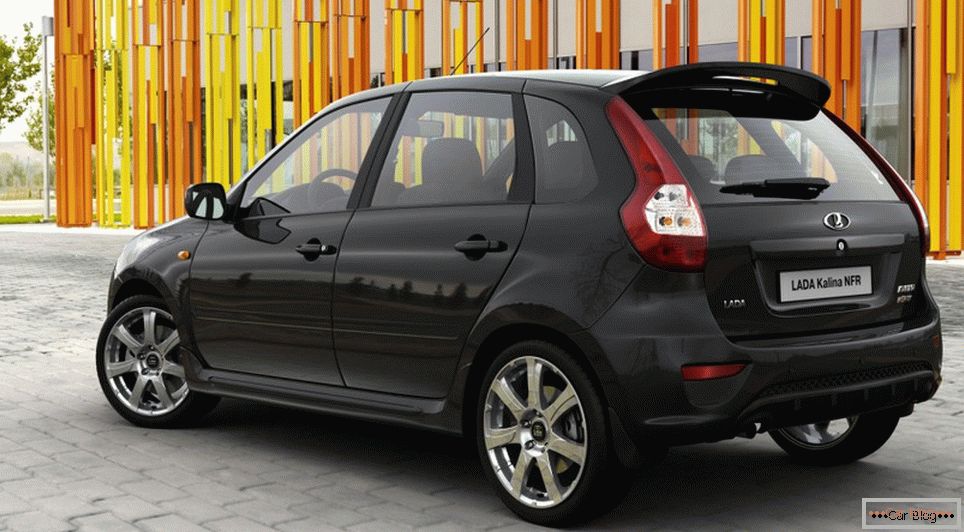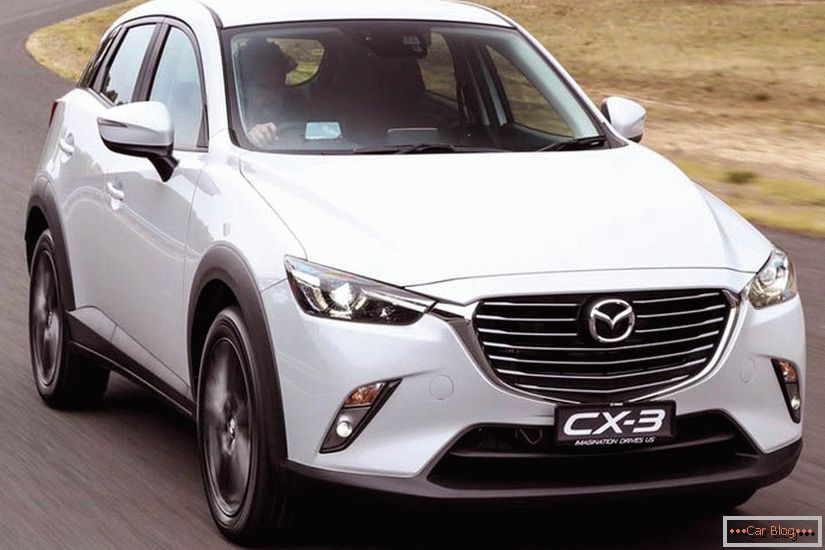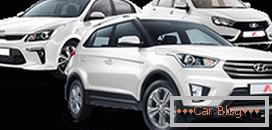All drivers, pedestrians and passengers must know and follow the rules of the road. An important influence in such a situation has to be paid to the study of road signs. In order to prevent dangerous for life and health violations, you need to clearly know all the signs prohibiting movement.
Content
- 1 General concepts
- 2 Easy classification
- 3 Decoding of prohibition signs from traffic rules
- 3.1 3.1 Entry prohibited
- 3.2 3.2 Movement prohibited
- 3.3 3.3 Movement of vehicles is prohibited
- 3.4 3.4 Forbidden to move trucks
- 3.5 3.5 Motorcycle ban
- 3.6 3.6 Tractors are prohibited to move.
- 3.7 3.7 Ban on trailers and 3.8 Ban on horse-drawn carts
- 3.8 3.9. Bicycle traffic is completely limited.
- 3.9 3.10 Prohibition of pedestrian traffic
- 3.10 C 3.11 at 3.15
- 3.11 3.16 Minimum allowed distance
- 3.12 3.17.1 to 3.17.3
- 3.13 3.18.1, 3.18.2, 3.19
- 3.14 3.20 Prohibition of overtaking
- 3.15 3.21 End of the overtaking zone
- 3.16 3.22 and 3.23
- 3.17 3.24 and 3.25
- 3.18 3.26 Inhibit sound signals
- 3.19 3.27 and 3.28
- 3.20 3.29 and 3.30
- 3.21 3.31 End of all restrictions
- 3.22 3.32 and 3.33
General concepts
When a round sign with a red ring around the perimeter is found on the right side of the road, it is necessary to increase vigilance, since prohibitive traffic signs look that way. Inside the circle there are information symbols, most of which are easily identifiable.
Important! Failure to comply with the prohibition indications entails punishment in the form of administrative liability.
It is necessary to take into account that in most cases the sign’s actions begin immediately after it. In this case, you need to notice them in a timely manner to prevent violations.
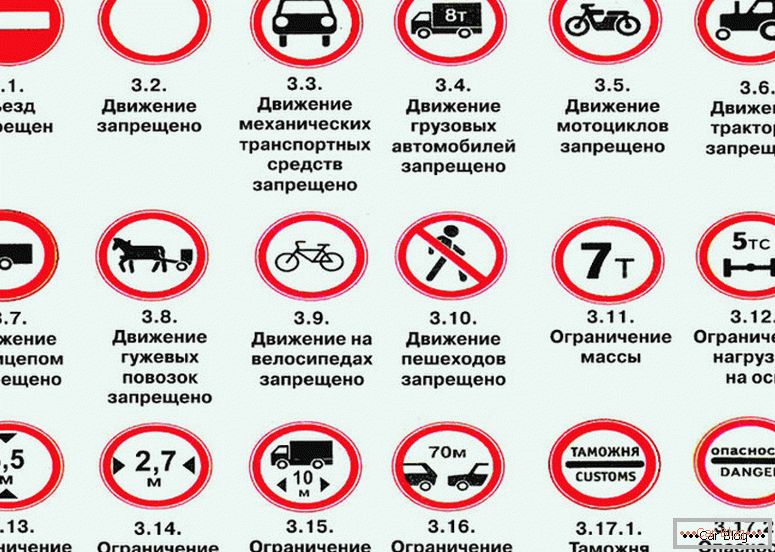
For many students of driving schools, prohibiting road signs, pictures with their image and decoding values mean some difficulties in memorizing. This attitude is associated with several factors:
- in traffic regulations there is a considerable number of prohibition signs, each of which is unique for decoding;
- Symbols are often used and interpreted quite deeply by road inspectors;
- Pointers have a number of exceptions and limitations, which imposes certain disagreements on them in the understanding of the inspector and the driver.
Easy classification
Remember, for example, the sign "Entry is prohibited", the picture of which is placed on the page, or another pointer of this type will help to group similar designations. Conventionally, for ease of perception, you can divide everything into such classes:
- the first part of the indexes does not allow penetration into the established area for all traffic participants or for certain groups, for example, cyclists or trucks (from 3.1 to 3.10, 3.32, 3.33);
- the second part of the indexes establishes the maximum allowable limit by weight category or by dimensional data (from 3.11 to 3.15);
- The third group includes signs that block subsequent movement, without necessarily stopping in front of them (from 3.17.1 to 3.17.3);
- the fourth part is characterized by the presence of crossed arrows in the center, since they do not allow movement in the indicated directions (3.18.1, 3.18.2, 3.19);
- The fifth group includes signs that impose restrictions on movement in any mode, for example, a ban on driving using a sound signal or a ban on parking on even days of the month (3.16, from 3.20 to 3.31).
Interpretation of prohibition signs from traffic rules
Let us examine the notation and understanding of all the signs that establish all sorts of unconditional bans on the roads.
3.1 Entry prohibited
The installed “Movement is prohibited” sign, the picture of which resembles an image of a brick, received a corresponding nickname from drivers. It is hanged on those areas, the entrance to which is supposed to close. Most often it can be found on the outskirts of gas stations, so that drivers are not confused with the arrival, over the public transport strip, etc.
The pointer is often used to block a one-way road. The plot of action of this sign ends after the nearest intersection.
It is important to know! The action of the pointer 3.1 has the right to ignore drivers on public route transport: buses, trolley buses or trams.
3.2 Movement prohibited
The movement of any transport in the zone of its action is not allowed. Exceptions in this case are allowed for a specific transport:
- route types of vehicles;
- cars operated by people with disabilities of 1 or 2 groups, having a corresponding designation on the glass;
- vehicles intended to serve the specified area, or cars belonging to residents of the region;
- mail services of federal value.
3.3 Movement of vehicles is prohibited
Under it can not drive cars or buses, but horse-drawn carts or cyclists way under it is open. Also in the exceptions falls the list from the previous paragraph.
3.4 Forbidden to move trucks
Passage is blocked for trucks weighing more than 3,500 kg or another indicated on the sign. Also, any self-propelled guns or tractors will be banned. Postal service or machines serving the site are allowed.
3.5. The ban on riding a motorcycle.
Do not drive a sign on any motorcycle, including them without wheelchairs or with wheelchair fastened. Exception for service vehicles and mail.
3.6 Tractors are prohibited to move.
Tractors do not go on by the rules of the road. Under the ban fall excavators, scrapers and other similar equipment. The standard may be ignored by residents of the area and the postal service.
See also: Signs prohibiting parking: coverage3.7 Ban on trailers and 3.8 Ban on horse-drawn carts
In the first case, cars with caravans are not allowed, and in the second case, all kinds of carts and cattle are not allowed. You also can not go on a sleigh.
3.9. Bicycle traffic is completely limited.
Not only bicycle owners, but also moped drivers cannot drive under the sign. It is only allowed to drive two-wheeled vehicles on the sidewalk, or if there is none, then it is necessary to drive along the shoulder to the right. The action ends at the nearest intersection.
3.10 Prohibition of pedestrian traffic
Disabled people, children on sledges, persons leading two-wheeled vehicles fall under it.
C 3.11 at 3.15
Obvious signs that limit weight and size. If they are made on a yellow background, then they are temporary.
3.16 Minimum allowed distance
Motor transport is prohibited to reduce the distance between the nearest vehicle. The area of operation is limited either by the appropriate plate or by the sign “End of all restrictions”.
3.17.1 to 3.17.3
Before each sign, you must stop and wait for permission for further movement.
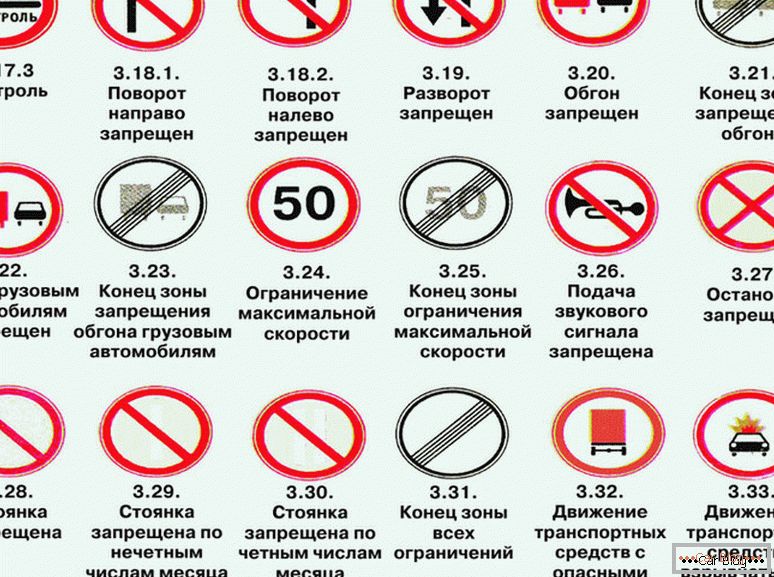
3.18.1, 3.18.2, 3.19
Signs prohibiting movement exclusively in the indicated directions. The designation on a yellow background indicates that the pointer is temporary.
It should be noted that 3.18.2 allows turning, and 3.19 allows turning to the left.
3.20 Prohibition of overtaking
The sign establishes a complete ban on overtaking throughout its entire area of action. Usually the interval is indicated in the information plate or to the nearest intersection. Does not apply to horse-drawn carts, bicycles, motorcycles without a cradle.
3.21 End of the overtaking zone
Removal of the relevant prohibitions.
3.22 and 3.23
Adjusting the zone of overtaking trucks.
3.24 and 3.25
Speed limit interval. When exceeding 10 km / h and falling out of the stream, the inspector can stop and warn. For exceeding 20 km / h there will be a fine. For exceeding 80 km / h, except for a fine, they will be deprived of rights.
3.26 The prohibition of sound signals
You cannot use sound in the marked area. The exception is the prevention of a traffic accident.
3.27 and 3.28
Signs prohibiting a stop and parking, respectively. Do not apply to people with disabilities, public transport, taxi drivers, postal service.
3.29 and 3.30
Drivers are not allowed to stand under the signs on odd or even days of the month, respectively.
3.31 End of all restrictions
Cancels restrictions imposed by other signs, including parking, overtaking, stopping and speed limits.
3.32 and 3.33
Pointers do not allow vehicles with dangerous goods and flammable explosives, respectively, to move beyond their range. Action signs ends after the nearest intersection.

